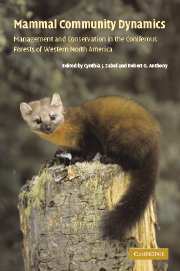 Mammal Community Dynamics
Mammal Community Dynamics Book contents
- Frontmatter
- Contents
- List of contributors
- Foreword
- Acknowledgments
- Part I Management and conservation issues for various taxa
- Part II Community and ecosystem relations
- Part III Conservation issues and strategies
- 16 Small mammals in a landscape mosaic: implications for conservation
- 17 Measuring and interpreting connectivity for mammals in coniferous forests
- 18 An evolutionary and behavioral perspective on dispersal and colonization of mammals in fragmented landscapes
- 19 The functional diversity of mammals in coniferous forests of western North America
- 20 Synopsis and future perspective
- Index
- References
16 - Small mammals in a landscape mosaic: implications for conservation
Published online by Cambridge University Press: 15 December 2009
- Frontmatter
- Contents
- List of contributors
- Foreword
- Acknowledgments
- Part I Management and conservation issues for various taxa
- Part II Community and ecosystem relations
- Part III Conservation issues and strategies
- 16 Small mammals in a landscape mosaic: implications for conservation
- 17 Measuring and interpreting connectivity for mammals in coniferous forests
- 18 An evolutionary and behavioral perspective on dispersal and colonization of mammals in fragmented landscapes
- 19 The functional diversity of mammals in coniferous forests of western North America
- 20 Synopsis and future perspective
- Index
- References
Summary
Introduction
Johnson (1980) provided a conceptual framework to describe habitat selection that identified four scales of selection: geographic range, home range, resource patches within home ranges, and specific resources necessary for survival (Fig. 16.1). The spatial scales over which these patterns of selection occur vary widely among species of mammals found in northwest coniferous forests. Harris (1984) estimated home range sizes for mammals in the Pacific Northwest and indicated they have a home range size distribution described by a negative exponential function (Fig. 16.2). Natural disturbance regimes common in Pacific Northwest coniferous forests (Spies and Turner 1999; Fig. 16.3) result in a distribution of patch sizes remarkably similar to this home range size distribution with frequent disturbances (sun flecks, small gaps, herbivores, and pathogens) creating small patches, and infrequent disturbances (fire, wind) creating larger patches. Indeed, inherent scales of disturbance in northwest coniferous forests under natural conditions likely represent the range of conditions and landscape mosaics that match evolved life histories of mammal species throughout the region. However, the effects of alterations in the spatial and temporal variability, pattern, and composition of the landscape caused by recent human disturbances, particularly timber harvest, raise questions regarding the continued persistence of diverse mammalian communities in managed forests (Lawlor 2003).
Landscapes are defined as the heterogeneous land area composed of an interacting mosaic of patches, at any scale, relevant to the phenomenon (e.g., species) under consideration (McGarigal and Marks 1995, McGarigal and McComb 1995).
- Type
- Chapter
- Information
- Mammal Community DynamicsManagement and Conservation in the Coniferous Forests of Western North America, pp. 567 - 586Publisher: Cambridge University PressPrint publication year: 2003
References
- 3
- Cited by


